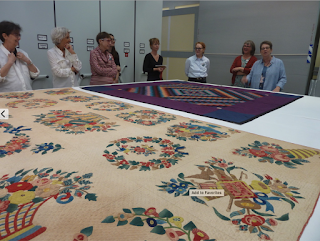 |
| Ms. Peck, with another curator, displays a sampler, dated 1827, by Barbara Landis. |
On May 9, I joined about a dozen other textiles fans in the Antonio Ratti Textile Center, located in a windowless lower level at the Metropolitan Museum in New York. Once a week, for three consecutive weeks, we enjoyed a look behind the scenes in an educational Short Course, as the Museum designates limited multi-session classes, entitled American Textiles. Each session began with a slide presentation by Amelia Peck, Marcia F. Vilcek Curator and Supervising Curator of the Ratti Center.
Since many textiles are fragile and hence not exhibited often, it was a special treat to gain visual access and learn more about the artifacts, as well as the Center, which houses and conserves more than 30,000 items in its storage facilities. Basically, all the texiles from all the various departments are housed here, with the exception of the Costume Insitute, which has separate facilities.
We were not allowed to photograph storage areas, but taking images of the artifacts was approved. This blog post won't go into detail about individual items - some links are provided to learn more - but just gives an idea of the course content and experience. Ms. Peck was assisted by a number of Center and museum staff; I didn't catch all of the names, but all were uniformly helpful, knowledgeable and friendly.
 |
| Learning about a white work quilt. |
The first session introduced us to the Ratti Center, and featured a presentation on textiles for beds, as well as curtains and carpets. Due to technical difficulties, I have no images from that session, but many of the Met's wonderful items can be viewed online.
The next week we moved onto American Schoolgirl Needlework and Embroidery, focusing on marking samplers, in which girls learned to stitch alpha-numeric characters, and pictorial samplers, featuring courting couples, pastoral views, and character-building aphorisms. I apologize for the photographic glare on the glass of the framed samplers.
From the samplers, it's clear girls' literacy was highly valued.
 |
| Marking sampler, Marian Boil, 1844. |
 |
| Pictorial embroidery, Laura Hyde, 1800. |
Our final session featured American quilts and coverlets, and I would recommend the book by Ms. Peck, American Quilts & Coverlets in the Metropolitan Museum of Art, 1990, and 2nd edition 2007. Here's a link to the 1990 edition PDF.
 |
| Fascinating 19th-century autograph quilt. |
 |
| A blurry image of Abraham Lincoln's signature on cloth. |
 |
| We learn about this unusual hand-woven coverlet. |
 |
| Detail of coverlet. |
One reason to study items like this is that by studying items made in the pre-industrial era, can we better understand the effects of technology on artistic expression and material culture. Even in this day and age of the celebrity selfie, we still value the individual, unique "John Hancock" and quilt-makers still incorporate signed pieces of fabric in special quilts. Modern examples include the Boston Red Sox-themed quilts by Rosemary Bawn, which incorporate the ball players signatures.
 |
| Discussing a crazy quilt. |
Quilts were much more than utilitarian objects even before the advent of central heating and increased indoor thermal control. Each piece of applique or patchwork represents a decision by the quiltmaker about color, placement, form and scale.
 |
| Pieced and embroidered quilt. |
 |
| Baltimore Presentation quilt. |
Some women developed their own unique designs, and other women adapted or copied shared designs (done by women) but each quilt is an expression of its maker's preferences and skills. Developing needlework designs for use by others, and teaching sewing skills, also provided employment for women. Textile arts are an area where necessity and leisure often meet and mingle.
 |
| Baltimore Presentation quilt, foreground, and Amish quilt adjacent. |
 |
| Baltimore Presentation quilt, detail. |
The Ratti Center is more than just a warehouse for items - it's a resource for scholars and inspiration for any maker working in fiber today. Much of the collection is online and anyone can gain access. Hours and contact info below. The database and library are available for public access and the staff can retrieve a few items at a time (with some exceptions for fragility, etc.) for visitors to view.
Antonio Ratti Center
Telephone: 212-650-2310
Fax: 212-650-2676
Email: RattiTextile.Center@metmuseum.org
Hours for Database and Library:
Monday through Friday: 10 am to 12:30 pm (appointment is recommended)
Hours for Study Rooms:
Monday through Friday: 2 to 4 pm (appointment is required)
 |
| Detail, crazy quilt. |